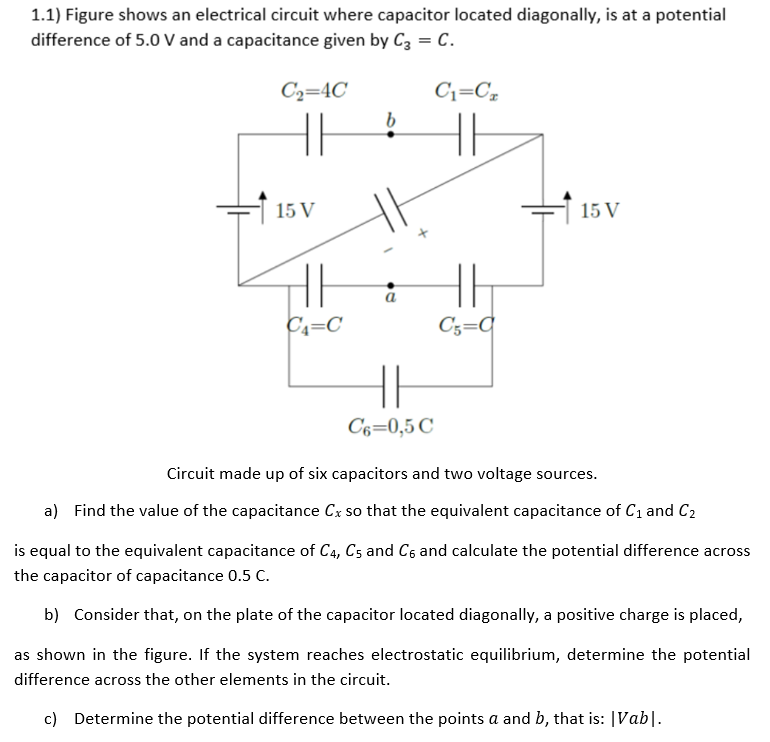1.1) Figure shows an electrical circuit where capacitor located diagonally, is at a potential difference of 5.0 V and a capacitance given by C3 = C. C₂=4C H 15 V HH C₁=C b C₁=CT HI C6=0,5 C HH C₁=C 15 V Circuit made up of six capacitors and two voltage sources. a) Find the value of the capacitance Cx so that the equivalent capacitance of C₁ and C₂ is equal to the equivalent capacitance of C4, C5 and C6 and calculate the potential difference across the capacitor of capacitance 0.5 C. b) Consider that, on the plate of the capacitor located diagonally, a positive charge is placed, as shown in the figure. If the system reaches electrostatic equilibrium, determine the potential difference across the other elements in the circuit. c) Determine the potential difference between the points a and b, that is: |Vabl.
1.1) Figure shows an electrical circuit where capacitor located diagonally, is at a potential difference of 5.0 V and a capacitance given by C3 = C. C₂=4C H 15 V HH C₁=C b C₁=CT HI C6=0,5 C HH C₁=C 15 V Circuit made up of six capacitors and two voltage sources. a) Find the value of the capacitance Cx so that the equivalent capacitance of C₁ and C₂ is equal to the equivalent capacitance of C4, C5 and C6 and calculate the potential difference across the capacitor of capacitance 0.5 C. b) Consider that, on the plate of the capacitor located diagonally, a positive charge is placed, as shown in the figure. If the system reaches electrostatic equilibrium, determine the potential difference across the other elements in the circuit. c) Determine the potential difference between the points a and b, that is: |Vabl.
Introductory Circuit Analysis (13th Edition)
13th Edition
ISBN:9780133923605
Author:Robert L. Boylestad
Publisher:Robert L. Boylestad
Chapter1: Introduction
Section: Chapter Questions
Problem 1P: Visit your local library (at school or home) and describe the extent to which it provides literature...
Related questions
Question
Please explain procedure

Transcribed Image Text:1.1) Figure shows an electrical circuit where capacitor located diagonally, is at a potential
difference of 5.0 V and a capacitance given by C3 = C.
C₂=4C
H
15 V
HH
C₁=C
b
C₁=CT
HI
C6=0,5 C
HH
C₁=C
15 V
Circuit made up of six capacitors and two voltage sources.
a) Find the value of the capacitance Cx so that the equivalent capacitance of C₁ and C₂
is equal to the equivalent capacitance of C4, C5 and C6 and calculate the potential difference across
the capacitor of capacitance 0.5 C.
b) Consider that, on the plate of the capacitor located diagonally, a positive charge is placed,
as shown in the figure. If the system reaches electrostatic equilibrium, determine the potential
difference across the other elements in the circuit.
c) Determine the potential difference between the points a and b, that is: |Vabl.
Expert Solution
This question has been solved!
Explore an expertly crafted, step-by-step solution for a thorough understanding of key concepts.
Step by step
Solved in 6 steps with 6 images

Recommended textbooks for you

Introductory Circuit Analysis (13th Edition)
Electrical Engineering
ISBN:
9780133923605
Author:
Robert L. Boylestad
Publisher:
PEARSON

Delmar's Standard Textbook Of Electricity
Electrical Engineering
ISBN:
9781337900348
Author:
Stephen L. Herman
Publisher:
Cengage Learning

Programmable Logic Controllers
Electrical Engineering
ISBN:
9780073373843
Author:
Frank D. Petruzella
Publisher:
McGraw-Hill Education

Introductory Circuit Analysis (13th Edition)
Electrical Engineering
ISBN:
9780133923605
Author:
Robert L. Boylestad
Publisher:
PEARSON

Delmar's Standard Textbook Of Electricity
Electrical Engineering
ISBN:
9781337900348
Author:
Stephen L. Herman
Publisher:
Cengage Learning

Programmable Logic Controllers
Electrical Engineering
ISBN:
9780073373843
Author:
Frank D. Petruzella
Publisher:
McGraw-Hill Education

Fundamentals of Electric Circuits
Electrical Engineering
ISBN:
9780078028229
Author:
Charles K Alexander, Matthew Sadiku
Publisher:
McGraw-Hill Education

Electric Circuits. (11th Edition)
Electrical Engineering
ISBN:
9780134746968
Author:
James W. Nilsson, Susan Riedel
Publisher:
PEARSON

Engineering Electromagnetics
Electrical Engineering
ISBN:
9780078028151
Author:
Hayt, William H. (william Hart), Jr, BUCK, John A.
Publisher:
Mcgraw-hill Education,